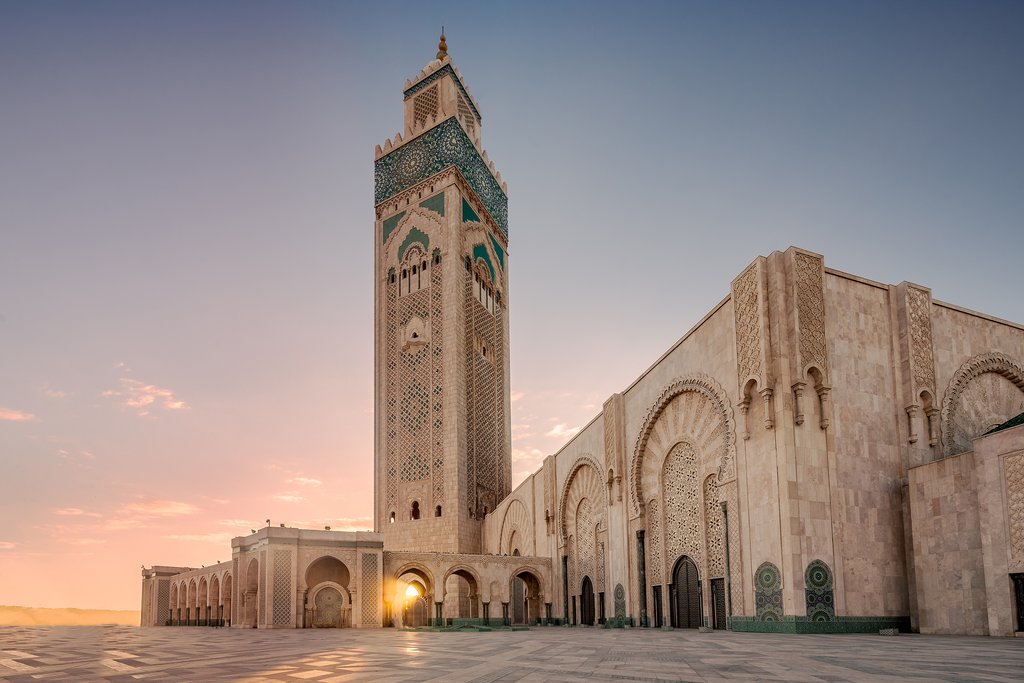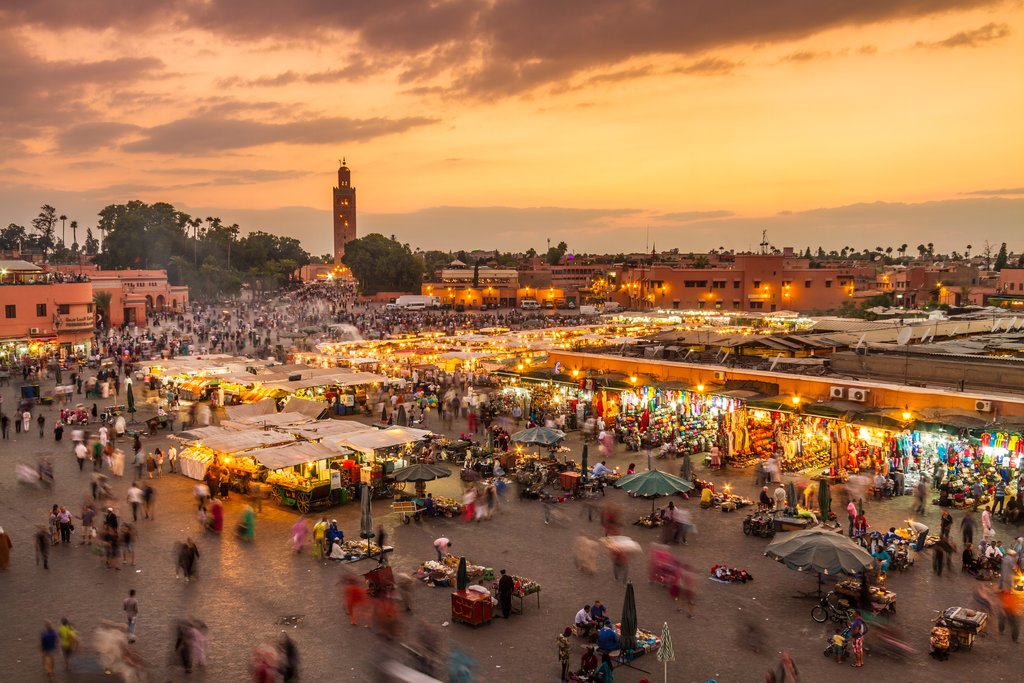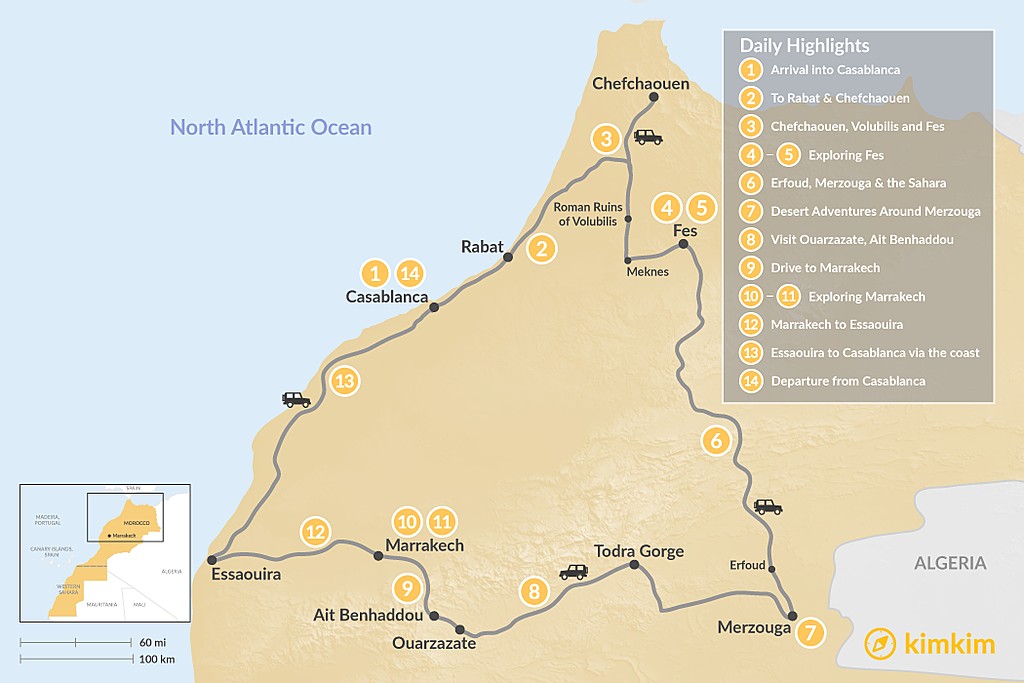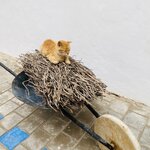Highlights
- Visit Casablanca and tour Hassan II, Morocco's largest mosque
- Discover souks, tanneries, and artisan workshops in medieval Fes
- Marvel at Chefchaouen's iconic blue-tinged architecture
- Follow ancient caravan routes and camp in the Sahara Desert
- Explore Marrakesh's palaces, souks, and tombs
Brief Itinerary
| Day | Highlights | Overnight |
|---|---|---|
| Day 1 | Arrive in Casablanca, Hassan II Mosque & Rabat | Rabat |
| Day 2 | Visit the Akchour Waterfalls & Chefchaouen | Chefchaouen |
| Day 3 | Tour the Volubilis Roman Ruins & Transfer to Fes | Fes |
| Days 4-5 | Explore Fes' Imperial City & Medieval Medina | Fes |
| Day 6 | Transfer to the Sahara Desert via Erfoud & Merzouga | Merzouga |
| Day 7 | Desert Adventures, Rissani Market & Todra Gorge | Todra Gorge |
| Day 8 | Transfer to Aït Benhaddou via Dades Valley | Aït Benhaddou |
| Day 9 | Transfer to Marrakesh via the High Atlas Mountains | Marrakesh |
| Days 10-11 | Explore the "Red City" of Marrakesh | Marrakesh |
| Day 12 | Transfer to Essaouira, Self-Guided Exploration | Essaouira |
| Day 13 | Transfer to Casablanca | Casablanca |
| Day 14 | Depart Casablanca |
Detailed overview
Day 1: Arrive in Casablanca, Hassan II Mosque & Rabat

Welcome to Morocco! Touch down in Casablanca, where your driver will be waiting to take you to your hotel in the heart of this vibrant port city. Settle in and tour Hassan II, Morocco's largest mosque. Inaugurated in 1993, the building's 650-foot (200 m) minaret is the highest structure in Morocco and the world's tallest minaret. The mosque is also unique because it's one of the few in Morocco that non-Muslims can enter.
Tour the historic complex, which includes a museum, baths, Koranic school, a library, and a prayer room that can hold 25,000 people, supported by 78 granite and marble pillars. Marvel at the mosque's elaborate mosaics, decorative wood, and ornamental ceilings, created by skilled artisans from across Morocco. For lunch, fans of the movie "Casablanca" should head to Rick's Café, a recreation of the eatery featured in this classic 1940s movie.
Afterward, travel north to Morocco's capital, Rabat, which is recognized as a UNESCO site for its impressive white architecture. Explore the city, starting with a trip to the Chellah Necropolis, where you can wander through Roman and Islamic ruins. Continue to the Hassan Tower and Mausoleum of Mohamed V, an abandoned 12th-century project that features the minaret of an incomplete mosque and some 200 columns.
Step back in time through an ornate doorway to the Kasbah des Oudaïas, the heart of the original city center, where you'll find spice-scented souks and the city's oldest mosque. Finish with a break from the crowds at the Andalusian Gardens, where paths lead through exotic flower gardens and fruit tree groves reminiscent of Spain's Alhambra Gardens.
Day 2: Transfer to Chefchaouen via the Akchour Waterfalls

Enjoy a scenic drive into the Rif Mountains this morning, stopping at Akchour Waterfall in Talassemtane National Park. Stretch your legs with a hike along a forested trail to the lower and upper falls, which are connected by God's Bridge. Watch the water crash into sparkling topaz pools, perfect for cooling off in after your trek.
Continue your journey to photogenic Chefchaouen, also known as the Blue City for its maze-like medina (old town) filled with bluewashed buildings. Set beneath the raw peaks of the Rif Mountains, the city's name translates to "two horns," a reference to the twin peaks that shadow the metropolis.
Chefchaouen was founded in 1471 by Idrisid Shorfa, descendants of the Prophet Mohammed, as a stronghold in the fight against the Portuguese. Revered as a holy mecca, the city is home to eight mosques and several zaouias (an Islamic place of worship, school, monastery, or mausoleum), and marabouts (Muslim religious leaders). The Grand Mosque, built in 1560, makes a stunning photo stop.
Wander the Plaza Uta el-Hammam, the city's main square, which is named for the hammams (public baths) that once encircled it. Find a restaurant or café for a bite to eat before browsing the many shops peddling traditional wares and then tour the old Kasbah and its eerie prison cells, used during Spanish rule. As evening approaches, follow the trail to the striking Spanish Mosque for sunset views over the city.
Day 3: Transfer to Fes via Volubilis Roman Ruins & Meknes

This morning, journey south toward Morocco's cultural capital, Fes. En route, you'll stop to visit the Roman ruins of Volubilis. Ramble through the streets of this once-grand settlement, which dates back to the third century and is listed as a UNESCO World Heritage site. Learn about the site's history as an Amazigh (Berber) city and its significance in establishing the first dynasty of the Kingdom of Morocco as you pass wealthy residential houses, temples, and public buildings with intricate mosaic floors.
Continue to nearby Meknes for lunch, followed by a wander around the city's colorful medina and Ville Impériale (Imperial City). Here, you'll discover Roman ruins, sultan tombs, palaces, and the city's vast underground prison and tunnel system. Don't miss the Dar Jamaï, a beautiful palace built in 1882.
Afterward, continue to Fes, pausing at Marinid Tombs, a hilltop archaeological site hosting the ruins of two 14th-century mausoleums. Here, you can enjoy panoramic views of the sprawling metropolis before descending into the winding city streets, where you'll check into your riad in time for dinner.
Days 4-5: Explore Fes' Imperial City & Medieval Medina

Spend the next two days exploring the UNESCO-listed city of Fes, the oldest of Morocco's four imperial capitals. Start by passing through the Moorish Bab Boujloud (Blue Gate) to tour the fortified medina. Your guide will lead you through bustling souks full of hand-crafted goods to the main thoroughfare of Talâa Kebira. Browse the bright collection of rugs, jewelry, and leather goods, or take in the towers of spices, dried fruits, and culinary delicacies.
You'll also visit the famous Chouara Tannery, with its extensive assortment of colorful leather dyes produced using centuries-old techniques. Next, head to the 9th-century Al-Qarawiyyin Mosque and University, the world's oldest continuously-operating university. Bou Inania Madrasa and Al Attarine Madrasa are equally impressive, two 14th-century schools featuring beautiful Marinid and Moroccan architecture, cedar woodwork, and zellij (mosaic tilework).
On your second day, wander through the mellah (Jewish district) and visit Musée Batha, home to Moroccan arts. Be sure to visit Fes el Jedid (new Fes) to see the Dar el Makhzen (Royal Palace of Fes). Soak up some culture in the afternoon with a local artisan workshop or perhaps a cooking class where you can learn to make Moroccan classics such as shakshuka (eggs poached in tomatoes), makouda (spiced battered potato cakes), and mechoui (spit-roasted lamb).
Chat with a local specialist who can help organize your trip.
Day 6: Transfer to the Sahara Desert via Erfoud & Merzouga

Travel south today toward Merzouga, a small town in the Sahara Desert. The journey will take you over the 7,146-foot (2,178m) Col du Zad pass through the cedar forests of the Middle Atlas mountains. Enjoy sightings of the local barbary macaque monkeys before stopping for lunch in Midelt (the "Apple City"). Continue over the Tizi n'Talremt Pass into the Ziz Valley, known for its palm trees and hidden oases. Along the way, you'll pass ksars (fortified castles) built to protect precious wares, including gold, salt, and spices.
Continue to the oasis town of Erfoud, known for its date festival and fossil mining. Here you can visit a local collective to meet some artisans before heading to Erg Chebbi, a vast sea of ever-shifting sand dunes that stretch for 13.5 square miles (35 square km). Upon reaching Merzouga, climb atop your camel and ride through the dunes to camp, where you'll spend the night in a traditional Bedouin tent. Trek up a nearby dune to watch the fiery sunset before returning to camp for a delicious dinner by the campfire.
Day 7: Desert Adventures, Rissani Market & Todra Gorge

Wake early to enjoy a desert sunrise, then choose to visit nearby villages or take an adrenaline-pumping sandboarding or ATV tour. Visit nearby Khemliya, a typical Saharan village, and experience traditional drumming, music, and dance before walking around the village. Next, you'll stop in the market town of Rissani, known for its livestock auction and impressive entrance gate.
This afternoon you'll drive to Tinghir, which offers sweeping views of neighboring towns that hug an extensive river oasis lined by 30 miles (48 km) of palm trees. Continue to today's final destination, the Todra Gorge. Carved by the Todra River, this natural, red-limestone wonder soars nearly 1,000 feet (305 m) high. Finish the day with a leisurely walk around the gorge, then relax in the cool waters of the shallow river below.
Day 8: Transfer to Aït Benhaddou via Dadès Valley

Travel along the Valley of a Thousand Kasbahs, passing through the dramatic gorges of the Dadès Valley. You'll pause in Kelâat M'Gouna to admire the cultivated rose bushes and visit a collective that produces rose water and oil. Make another optional stop in Ouarzazate, the movie capital of North Africa, where movies such as "Lawrence of Arabia," "Gladiator," and "Black Hawk Down" were filmed. Learn more on a movie studio tour and the Musée du Cinema.
Spend the afternoon exploring UNESCO-listed Aït Benhaddou. The old ksar (castle) was an essential stop on the trans-Saharan trade route in the 11th century. Wander the alleys and passageways of the old town and climb up to the old Granary, which offers views of the kasbah and surrounding area. "Game of Thrones" fans may want to trek down to the river to see the gates featured in the popular HBO series. Long after the day crowds have left, enjoy a quiet dinner overlooking the valley.
Day 9: Transfer to Marrakesh via the High Atlas Mountains

Leave Aït Benhaddou behind to begin the ascent over the High Atlas mountains. Along the way, you'll spot Mount Toubkal, the range's highest peak, at 13,671 feet (4,167 m). Stop in Taddert to visit an argan oil cooperative and learn how the argan nut and fruit are processed. As you descend the mountains, you'll notice a dramatic change in the climate and landscape as the rocks transform into flat plains and you approach the sprawling city of Marrakesh.
After a long day on the road, settle into your hotel and spend the rest of the afternoon as you like, perhaps enjoying a calm walk through the gardens behind the Koutoubia Mosque. In the early evening, Jemaa el-Fna comes alive with musicians, performers, snake charmers, games, and food stalls. If you want to enjoy the spectacle from a distance, choose one of the many cafés surrounding the square and enjoy a cup of mint tea and a meal.
Days 10-11: Explore the "Red City" of Marrakesh

Spend the next two days exploring Marrakesh, known as the Red City for its 1,000-year-old red sandstone walls and buildings. The city has Berber roots and was once a key trading hub for tribes in the Atlas mountains. Start in the city's heart, Jemaa el-Fna, and wander north to the labyrinthine souks home to everything from spices to ceramics and leather goods.
Other highlights include the city's largest mosque, Koutoubia, with its 12th-century foundations and minaret, and the peaceful Majorelle Gardens, an oasis of subtropical plants and palm trees. Tour the eerie Saadien Tombs, which date back to 1557, and explore Bahia Palace, famed for its embellished woodwork and painted ceilings. To the south of the city, you'll find the 17th-century El Badi Palace, with its extensive courtyards and sunken gardens.
On your second day, meet a local guide for a half-day tour of the Ben Youssef Madrasa school of Islam, where you'll get a taste of lavish 16th-century architecture. Admire the traditional Moroccan artisanship: carved cedar, sculpted plaster, arabesques, Islamic calligraphy, and colorful zellij. Wander the old dorms where up to 800 students once lived and visit the prayer hall.
Spend time exploring the Dar Di Said Museum (Museum of Moroccan Arts), which has a clothing collection, antiques, jewelry, and beautifully carved Hispano-Moorish decorations. Afterward, indulge your senses in Marrakesh's maze-like souks, including Souk el Attarin, Souk Chouari, and Souk Smata for a selection of spices, woodwork, and babouche (traditional Moroccan slippers). Visit Souk des Teinturiers (the dyers' souk) to see how leather hides and cloth are dyed.
Day 12: Transfer to Essaouira, Self-Guided Exploration

This morning, head west through rolling plains and argan forests to the coastal city of Essaouira, which translates to "fortified palace" in Arabic. The port city is protected by the Skala de la Kasbah, 18th-century seafront ramparts that offer sweeping sea views and are lined with brass canons. Watch sky-blue boats bobbing in the port and waves crashing onto the beach.
Spend the rest of the day exploring Essaouira independently. Ramble through the UNESCO-protected medina, where you can shop in the buzzing marketplace, before heading to the beach for relaxation. Walk back to Essaouira in time to enjoy a meal of freshly-caught seafood while watching the sunset over the city's ancient ramparts.
Day 13: Transfer to Casablanca

Known as the "Windy City" for its strong Alizé trade winds that hit its crescent beach, Essaouira is a popular kiteboarding destination. Spend the morning watching the windsurfers and kiteboarders ride the waves, or if you're feeling adventurous, take a lesson yourself. Afterward, you'll make the five-hour coastal drive back to Casablanca, stopping for breaks in seaside towns.
Day 14: Depart Casablanca

Today your grand Morocco tour comes to an end. Your driver will take you to Casablanca airport in time to catch your homebound flight. Safe travels!
More Great Morocco Itineraries
Looking for more inspiration for your trip to Morocco? Check out these other Morocco itineraries, explore different ways to spend two weeks in Morocco, or discover the best time to visit Morocco.








